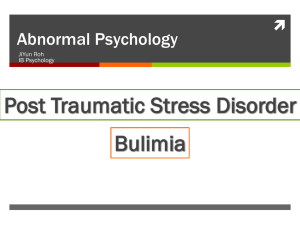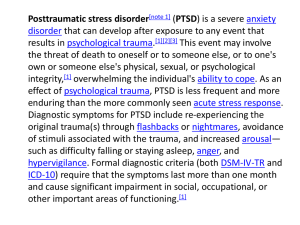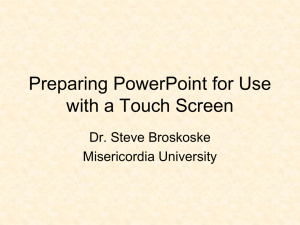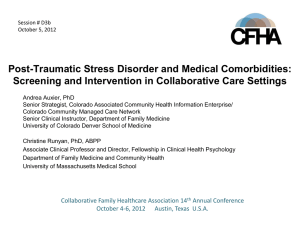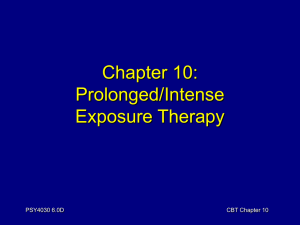Dia 1 - European Society for Traumatic Stress Studies
advertisement
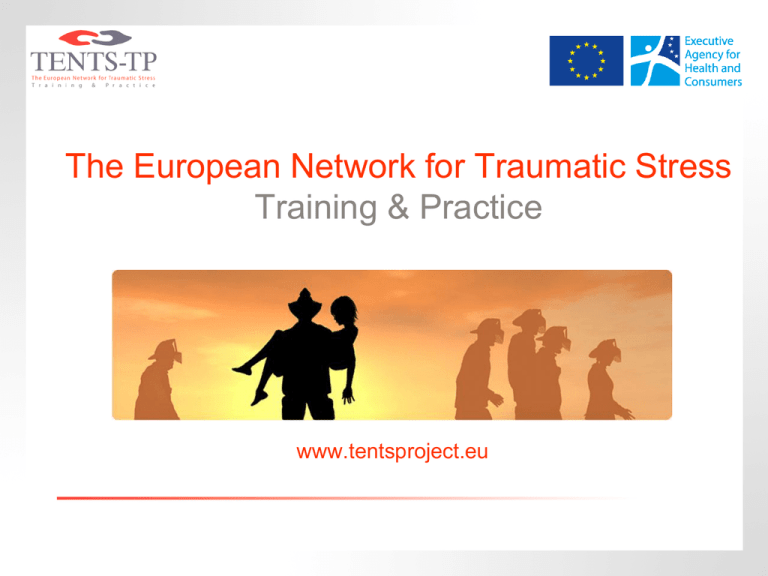
The European Network for Traumatic Stress Training & Practice www.tentsproject.eu Cognitive Therapy and the treatment of PTSD and ASD Chris Freeman MD Contents What is CBT General principles of psychological treatment A typical course of treatment Evidence base for CBT in PTSD Evidence base for CBT in Acute stress disorder CBT compared with other psychological treatments and drugs What is CBT • Several different models of CBT but all share some common characteristics • Even EMDR has some CBT principles but it will be covered in a separate set of slides • Brief Eclectic Therapy (BEP) has some CBT techniques but is a separate psychotherapy despite being grouped with CBT by NICE. (National Institute of Clinical Excellence UK) General principles of psychological treatment • Assessment and formulation is crucial • This should be carried out before ASD and PTSD treatment. CBT for PTSD. The Evidence Ways of changing trauma memories : How CBT models differ. • Prolonged exposure to trauma memory (Foa: imaginal reliving; Resick: trauma narrative) • Updating worst moments in memory (Ehlers & Clark) • Brief exposure to image with rapid eye movements or other bilateral stimulation (Shapiro) • In vivo exposure • Discrimination of triggers (Ehlers & Clark) Evidence Base reviewed by NICE • EMDR: 11 studies compared with W/L or other psychological interventions • CBT: 16 studies compared with W/L or other psychological interventions • ECBT: 16 studies compared with W/L or other psychological interventions • SM: 7 studies compared with W/L or other psychological interventions • GCBT: 4 studies compared with W/L or other psychological interventions • Other: 6 studies compared with W/L or other psychological interventions NICE Guidelines 2005: Systematic Review of Psychological Treatments for PTSD – Effect sizes compared to wait list TF-CBT 13 RCTs EMDR 4 RCTs CBT: Stress management 3 RCTs Other A priori threshold d = .08 2 RCTs 0 0.5 1 1.5 2 Psychological Interventions • Exposure based CBT demonstrated more clinically important effects on self report PTSD symptoms and PTSD diagnosis than W/L. • Limited evidence of superiority on clinician rated PTSD symptoms , depression and anxiety • Not superior to stress management or other treatments and outcomes varied substantially Psychological Interventions • EMDR found support but not as strong as TFCBT • Clinically important benefits on clinician rated but not self report PTSD symptoms compared to W/L • Limited evidence for clinically important effects on anxiety and depression • EMDR was superior to supportive/non-directive therapy but not stress management. Evidence base since NICE • Several new studies but no change in conclusions above • 4 additional studies comparing trauma focussed CBT with waiting list • I additional study comparing trauma focussed CBT with other treatment Recommendations from evidence base: 1 • All PTSD sufferers should be offered a course of trauma focused psychological therapy on an individual, out-patient basis (A) • Trauma focused psychological interventions should be offered regardless of the time elapsed since the trauma (B) Recommendations from evidence base: 2 • CBT should be offered even if key trauma was a long time ago • Individual face to face therapy is first choice • Course of treatment for a single trauma is 8-12 60 min. sessions • Treatment must be flexible with longer sessions if trauma story being related. Recommendations from evidence base: 3 • Trauma focused psychological interventions should be 8-12 sessions long when the PTSD has arisen from a single incident. (B) • If the traumatic event is being discussed sessions should be longer (90 mins), offered on a regular and continuous basis (weekly) with the same person. (B) Recommendations from evidence base: 4 • In cases of multiple trauma, traumatic bereavement, chronic disability arising from the trauma, significant co-morbidity or social problems longer treatment duration should be considered (> 12 sessions). (C) • Treatment should be delivered by competent individuals with appropriate training and supervision. (C) Acute Stress Disorder (ASD) • Evidence recently reviewed by Roberts 2009 • Evidence supports effectiveness of trauma focussed CBT over control • Self help booklets are not superior to control condition (Ehlers 2003) • Studies that offer brief treatment (5 sessions) treat ASD and PTSD symptoms but not depression or anxiety. • Need longer treatment 12 hours + to treat wider symptoms Acute Stress Disorder • Studies have tended to treat patients in first 3 months so subjects are a combination of ASD and acute PTSD • Evidence base is very similar to PTSD but fewer studies ASD • Sessions should be 90 minutes long if using imaginal exposure • Combination treatments should not be used • Treatment should be individual not group • Treatment should not begin within 2 weeks of the trauma Training for therapy • Used to assumed that therapists needed to be competent in general CBT and then trained in Trauma Focussed CBT • Northern Ireland studies show this may not be necessary Drug treatment compared with psychotherapy • No head to head trials so we have to assess drug trial evidence separately and compare at a clinical level What are essential ingredients • • • • • Trauma focussed Target trauma memories Target trauma beliefs and meanings Provide exposure Provide a safe secure setting Drop out rates: different CBT models compared • Different psychological treatments may not differ much in symptom reduction • They do differ significantly in acceptability General points on effectiveness of CBT (effectiveness v.s. efficacy) • 67% of those who complete treatment no longer meet PTSD criteria • But: pre post symptom scores negatively correlated with drop out rates indicating that those who don’t improve may drop out • Trials exclude approx. 30% of referrals which is lower than for other diagnoses e.g.. Depression • Combat related PTSD consistently shows poorer outcome




